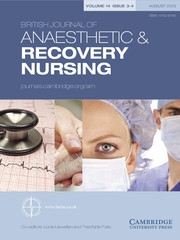No CrossRef data available.
Article contents
Parental Refusal of Consent for their Child's Medical Treatment: An Ethical, Professional and Legal Dilemma
Published online by Cambridge University Press: 03 April 2013
Abstract
Parental refusal to consent for medical and surgical consent can present children's nurses with a professional dilemma and can potentially negatively impact the care provided for the both the paediatric patient and their family. With in this article, the legal, ethical and professional aspects associated with this dilemma are presented and discussed from the parental, child and nurse point of view.
- Type
- Original Article
- Information
- Copyright
- Copyright © British Association of Anaesthetic and Recovery Nursing 2013
References
Beauchamp, T, Childress, J. Principles of Biomedical Ethics, 5th edn. New York: Oxford University Press, 2001.Google Scholar
Bristol Royal Infirmary Inquiry (Kennedy Report) (2001) Learning from Bristol: the report of the public inquiry into children's heart surgery at the Bristol Royal Infirmary 1984–1995. Retrieved 14 July 2011 from http://www.bristol-inquiry.org.uk/final_report/Summary.pdfGoogle Scholar
British Medical Association (BMA). Consent, Rights and Concerns in Healthcare for Children and Young People. London: BMJ Books, 2001.Google Scholar
Charles-Edwards, I, Glasper, EA. Ethics and children's rights: learning from past mistakes. British Journal of Nursing 2002; 11(17): 1134–1140.Google Scholar
Coles, L, Glasper E, A, Fitzgerald, C, LeFluffy, T, Turner, S, Wilkes-Holmes, C. Measuring compliance to the NSF for children and young people in one English strategic health authority. Journal of Children's and Young People's Nursing 2007; 1(1): 7–15.Google Scholar
Cornock, MA. Fraser guidelines or Gillick competence? Journal of Children's and Young People's Nursing 2007; 1(3): 142.Google Scholar
Coyne, I. Children's participation in consultations and decision making at health service level: a review of the literature. International Journal of Nursing Studies 2008; 45(11): 1682–1689.CrossRefGoogle Scholar
Delany, L. The legal perspective. In: Tingle J, Cribb A (eds). Nursing Law and Ethics. Great Britain: Blackwell Publishing, 2007, 223pp.Google Scholar
Department of Health (DH) (2001) Consent – what you have the right to expect: a guide for children and young people. Retrieved 8 June 2011 from http://www.dh.gov.uk/prod_consum_dh/groups/dh_digitalassests/@dh/@en/documents/digitalassest/dh_4116903.pdfGoogle Scholar
DH (2004) National service framework for children, young people and maternity services: Executive summary. Retrieved 15 May 2011 from http://www.dh.gov.uk/prod_consum_dh/groups/dh_digitalassests/@dh/@en/documents/digitalasset/dh_4090552.pdfGoogle Scholar
DH (2009) Reference guide to consent for examination or treatment; second edition. Retrieved 13 July 2011 from http://www.dh.gov.uk/prod_consum_dh/groups/dh_digitalassets/documents/digitalasset/dh_103653.pdf.Google Scholar
Dickey, SB, Kiefner, J, Beidler, SM. Consent and confidentiality issues among school age children and adolescents. Journal of School Nursing 2002; 18(3): 179–186.Google Scholar
Dimond, B. Legal aspects of consent: when parents are overruled. British Journal of Nursing 2001; 10(13): 880–881.Google Scholar
Dimond, B. The mental capacity act 2005: children and young people. British Journal of Nursing 2008; 17(4): 248–250.Google Scholar
Farsides, B. An ethical perspective – consent and patient autonomy. In: Tingle J, Cribb A. (eds). Nursing Law and Ethics, 2nd edn. UK: Blackwell Publishing, 2007, 143pp.Google Scholar
Fullbrook, S. Consent: the issue of rights and responsibilities for the healthcare worker. British Journal of Nursing 2007a; 16(5): 318–319.Google Scholar
Fullbrook, S. Best interests. A review of the legal principles involved: part 2(a). British Journal of Nursing 2007b; 16(11): 682–683.Google Scholar
Gibson, F. The cultural context of communicating complex information to parents of children with cancer – not just a linguistic obstacle (editorial). European Journal of Oncology Nursing 2008; 12(1): 2–3.Google Scholar
Glasper, A. Encouraging young people to participate in their health services. British Journal of Nursing 2010; 19(11): 716–717.Google Scholar
Griffith, R. The issue of consent and children: who decides? British Journal of Community Nursing 2004; 9(7): 298–301.Google Scholar
Griffith, R. Consent and children: the law for children under sixteen. British Journal of School Nursing 2008; 3(6): 281–283.CrossRefGoogle Scholar
Griffith, R, Tengnah, C. Law and Professional Issues in Nursing, 2nd edn. England: Learning Matters Limited, 2010.Google Scholar
Harrington-Jacobs, H. Ethics in paediatric end-of-life care: a nursing perspective. Journal of Pediatric Nursing 2005; 20(5): 360–369.Google Scholar
Howlin, F. Understanding advocacy in children's nursing: a Hermeneutic study. Journal of Children's and Young People's Nursing 2008; 2(3): 115–125.Google Scholar
Nursing and Midwifery Council (NMC) (2008) The code: standards of conduct, performance and ethics for nurses and midwives. Retrieved 13 July 2011 from http://www.nmc-uk.org/Nurses-and-midwives/The-code/The-code-in-full/Google Scholar
Mayberry, M, Mayberry, J. Consent in Clinical Practice. UK: Radcliffe Medical Press, 2003.Google Scholar
McLeod, A. The sources of ethical deliberation in neuroscience nursing: three case scenarios. British Journal of Neuroscience Nursing 2005; 1(5): 237–242.CrossRefGoogle Scholar
O'Brien, I, Duffy, A, O'Shea, E. Medical futility in children's nursing: making end-of-life decisions. British Journal of Nursing 2010; 19(6): 352–356.CrossRefGoogle Scholar
Orr, FE. The role of the paediatric nurse in promoting paediatric right to consent. Journal of Clinical Nursing 1999; 8(3): 291–298.Google Scholar
Pocock, M. A critical analysis of legal and ethical issues regarding consent in childhood. Nurse Prescribing 2003; 1(4): 180–185.CrossRefGoogle Scholar
Purssell, E. Listening to children: medical treatment and consent. Journal of Advanced Nursing 1995; 21(4): 623–624.Google Scholar
Royal College of Nursing (RCN) (2003). Children and young people's nursing: a philosophy of care. Guidance for nursing staff. Retrieved 13 July 2011 from http://www.rcn.org.uk/__data/assets/pdf_file/0003/78573/002012.pdfGoogle Scholar
Taylor, B. Parental autonomy and consent to treatment. Journal of Advanced Nursing 1999; 29(3): 570–576.Google Scholar
Thornberry, M. Safeguarding children: an essential guide. Practice Nursing 2010; 21(4): 178–183.Google Scholar
Wheat, K. Applying ethical principles in healthcare practice. British Journal of Nursing 2009; 18(17): 1062–1063.Google Scholar
Whitty-Rogers, J, Alex, M, MacDonald, C, Perrynowski Gallant, D, Austin, W. Working with children in end-of-life decision making. Nursing Ethics 2009; 16(6): 743–758.CrossRefGoogle ScholarPubMed
Woods, M (2001) Balancing Rights and Duties in ‘Life and Death’ Decision Making Involving Children: A Role For Nurses? Nurse Ethics. 8: 397-408.Google Scholar


